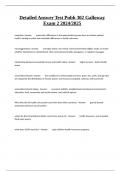Detailed Answer Test Pubh 302 Galloway
Exam 2 2024/2025
inequities Answer: systematic differences in the opportunities groups have to achieve optimal
health, leading to unfair and avoidable differences in health outcomes
microaggressions Answer: everyday verbal, non-verbal, and environmental slights, snubs, or insults
whether intentional or unintentional--that communicate hostile, derogatory, or negative messages
relationship between household income and health status Answer: higher income = better health
status
social determinants Answer: the conditions in which people are born, grow, live, work, and age that
are shaped by the distribution of money, power, and resources at global, national, and local levels
social determinants shape: Answer: economic stability, neighborhood and physical environment,
education, food, community and social context, and cultural aspects
Why does the US health care system cost more than other countries? Answer: geared toward
treatment and lesser so prevention
where do the US healthcare dollars come from and go to> Answer: health insurance, out-of-pocket,
third party payers
what does SCHIP stand for? Answer: state children health insurance programs
, what does SCHIP do? Answer: partnership between federal and state governments that provides
health coverage to uninsured children whose families earn too much to qualify for Medicaid, but too
little to afford private coverage
How is SCHIP paid for? Answer: funded in part by tobacco tax (depending on the state)
utilization trends Answer: aging population, diversity in the population, income/insurance status,
family structure, specific chronic conditions (cancer, HIV/AIDS)
resource trends 1 Answer: supply to meet demand
resource trends 2 Answer: increased medical sub-specialities, decreased primary care
resource trends 3 Answer: decreased community hospitals, length of stay, admissions
resource trends 4 Answer: increased hospital employees and outpatient services
resource trends 5 Answer: paying to keep people out of hospitals
Affordable Care Act Answer: An expansion of medicaid, most of employers must provide health
insurance, have insurance or face surtax, prevents rejection based on pre-existing condition. Also
referred to as "Obamacare", signed into law in 2010.
ACA Answer: reforms private health insurance market, provide better coverage for those with pre-
existing conditions, improves prescription drug coverage in Medicare, extend the life of the Medicare
trust fund by at least 12 years, health insurance exchanges
ACA goal Answer: provide health insurance to the uninsured (universal coverage)




